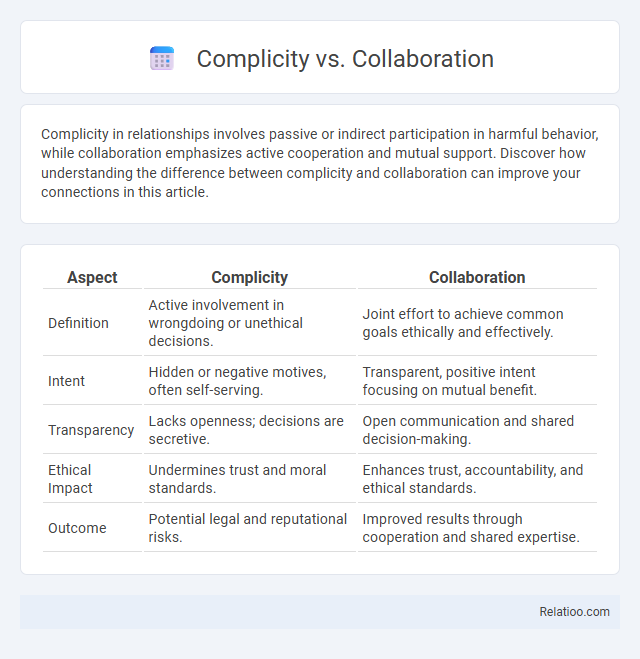Complicity in relationships involves passive or indirect participation in harmful behavior, while collaboration emphasizes active cooperation and mutual support. Discover how understanding the difference between complicity and collaboration can improve your connections in this article.
Table of Comparison
| Aspect | Complicity | Collaboration |
|---|---|---|
| Definition | Active involvement in wrongdoing or unethical decisions. | Joint effort to achieve common goals ethically and effectively. |
| Intent | Hidden or negative motives, often self-serving. | Transparent, positive intent focusing on mutual benefit. |
| Transparency | Lacks openness; decisions are secretive. | Open communication and shared decision-making. |
| Ethical Impact | Undermines trust and moral standards. | Enhances trust, accountability, and ethical standards. |
| Outcome | Potential legal and reputational risks. | Improved results through cooperation and shared expertise. |
Understanding Complicity: Definition and Context
Complicity involves knowingly participating in or enabling wrongful acts, often by aiding or abetting harmful behavior without direct execution. Collaboration refers to working jointly with others towards a common goal, which can be positive or negative depending on the context, while complicity specifically implies moral or legal responsibility in wrongdoing. Understanding complicity requires examining the intent, awareness, and the extent of involvement in unethical or illegal activities within social, legal, or organizational settings.
Defining Collaboration: Key Characteristics
Collaboration involves active participation and mutual engagement among individuals or groups working towards a shared goal, characterized by open communication, trust, and a willingness to share resources and responsibilities. Unlike complicity, which implies silent association or passive involvement in wrongdoing, collaboration demands intentional and cooperative effort to achieve positive or constructive outcomes. Key characteristics include joint decision-making, transparency, and a commitment to collective success.
Complicity vs Collaboration: Core Differences
Complicity involves knowingly assisting or enabling wrongdoing, while collaboration refers to working together towards a common goal, which can be either ethical or unethical. You must understand that complicity implies a level of guilt due to conscious participation in harmful actions, whereas collaboration does not inherently involve wrongdoing. The core difference lies in intent and awareness, with complicity carrying moral or legal consequences, unlike neutral or positive collaboration.
Historical Examples of Complicity and Collaboration
Historical examples of complicity often involve individuals or groups passively enabling harmful regimes, such as civilians in Nazi Germany who ignored or silently accepted atrocities. Collaboration, by contrast, typically refers to active cooperation with occupying forces or oppressive powers, exemplified by the Vichy government in France during World War II. Your understanding of these concepts deepens by examining how complicity can blur with collaboration, highlighting the moral complexities faced during periods of conflict and oppression.
Ethical Implications: Where Lines Are Drawn
Complicity involves passive allowance of wrongdoing without direct participation, while collaboration requires active cooperation in unethical actions, both carrying significant ethical implications for accountability and responsibility. Your moral boundary is tested as complicity blurs ethical lines, often implicating individuals in harm through omission, whereas collaboration denotes clear ethical violations via deliberate involvement. Drawing a distinct line between these concepts is crucial for justice systems and organizational ethics to appropriately assign culpability and guide ethical behavior.
Motivations: Why People Become Complicit or Collaborate
People become complicit or collaborate due to a complex interplay of motivations including fear of repercussions, desire for personal gain, or social pressure to conform. Complicity often arises from passive acceptance or inability to oppose wrongdoing, while collaboration involves active participation driven by aligned interests or coercion. Understanding these psychological and situational factors is essential in addressing ethical breaches and fostering accountability.
Legal Perspectives: Responsibility and Accountability
Complicity, collaboration, and conspiracy each define different levels of legal responsibility and accountability in criminal acts. Complicity involves assisting or encouraging the principal offender, making you liable for the crime even without direct participation. Collaboration may encompass lawful cooperation but crosses into criminal territory when it involves planning or facilitating illegal activities, while conspiracy specifically refers to an agreement between two or more parties to commit a crime, establishing clear grounds for legal accountability.
Social Perceptions: Stigma and Acceptance
Social perceptions of complicity, collaboration, and cooperation vary significantly in terms of stigma and acceptance, with complicity often carrying negative connotations of guilt and wrongdoing. Collaboration tends to be viewed more positively, associated with mutual support and constructive engagement, while cooperation is generally accepted as a neutral or beneficial interaction. Understanding these distinctions can help you navigate and interpret social judgments within group dynamics and accountability contexts.
Navigating Ambiguity: Blurred Boundaries in Practice
Navigating ambiguity in the context of complicity, collaboration, and compliance involves recognizing the nuanced and often overlapping roles individuals or organizations may play in complex ethical or legal situations. Complicity refers to being involved with others in wrongdoing, often passively, while collaboration emphasizes active cooperation toward a shared goal, which can be either positive or negative depending on context. Compliance focuses on adhering to rules or regulations, but blurred boundaries arise when following orders or policies implicitly supports unethical actions, making it challenging to distinguish between complicity and legitimate collaboration.
Strategies for Ethical Collaboration
Strategies for ethical collaboration emphasize transparency, mutual respect, and clear communication to ensure all parties contribute positively without enabling harmful actions. Understanding the distinctions between complicity, collaboration, and conspiracy helps your team avoid unintentional ethical breaches while fostering trust and accountability. Prioritizing shared values and proactive conflict resolution strengthens your ability to collaborate responsibly and ethically.

Infographic: Complicity vs Collaboration
 relatioo.com
relatioo.com